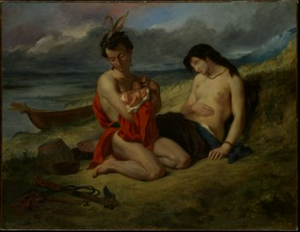The Orchestra Now Presents 'Dvořák, Busoni, And Delacroix: The New World' at the Met Museum
The performance is Sunday, April 10, 2022 at 2 PM.

The Orchestra Now (TŌN) will present the final program in the 2021-22 season of its popular Sight & Sound series at The Metropolitan Museum of Art on Sunday, April 10. The program, led by Leon Botstein, focuses on the European fascination with the unfamiliar culture of native peoples in the New World by exploring connections among Eugène Delacroix's painting The Natchez and other artworks, and music by composers Ferruccio Busoni and Antonín Dvořák. Soloist Wynona Wang, first-prize winner of the 2018 Concert Artists Guild International Competition, performs Busoni's rarely heard Indian Fantasy for piano and orchestra.
In all Sight & Sound concerts, conductor and music historian Leon Botstein explores the parallels between orchestral music and the visual arts. On-screen artworks are staged in a lively discussion alongside musical excerpts performed by the Orchestra, followed by a full performance and audience Q&A.
The next TŌN performance in NYC will be a Carnegie Hall concert showcasing rarely-heard masterworks from the late 1930s by William Grant Still, Carlos Chávez, Witold Lutosławski, and Karl Amadeus Hartmann on May 12.
Dvořák, Busoni, and Delacroix: The New World
Sunday, April 10, 2022 at 2 PM
Leon Botstein, conductor
Wynona Wang, pianist
Antonin Dvořák: Symphony No. 9, "From the New World" (second movement)
Ferruccio Busoni: Indian Fantasy for piano and orchestra
Eugène Delacroix: The Natchez
From their earliest encounters in the New World, Europeans were mesmerized by the indigenous peoples of North America. French Romantic artist Eugène Delacroix painted a Natchez family during the 1730s massacre of their tribe by French forces, and their flight up the Mississippi River. In the Paris Salon catalogue description of the work, the artist explained "During the voyage, the woman was taken by pain of labor. The moment is that when the father holds the newborn in his hands, and both regard him tenderly." Ferruccio Busoni's Indian Fantasy (1913-14) is inspired by indigenous melodies and rhythms recorded by Natalie Curtis Burlin, a pioneer in American ethnomusicology who had studied with the composer. Antonín Dvořák's New World Symphony, premiered by the New York Philharmonic in 1893, was written while the composer was living in New York City as director of the National Conservatory of Music, founded to create a style independent from European composers. The Symphony's second movement was inspired by Longfellow's poem on Hiawatha.
Eugène Delacroix's The Natchez is on view at The Metropolitan Museum of Art in the 19th and Early 20th Century European Paintings and Sculpture collection.
Tickets priced at $30-$50, include same-day museum admission and may be purchased online here, by calling The Met at 212.570.3949, or at any desk in The Great Hall at The Met Fifth Avenue. Ticket holders will need to comply with the venue's health and safety requirements, which can be found here.
The Orchestra Now
The Orchestra Now (TŌN) is a group of 60 vibrant young musicians from 13 different countries across the globe: Canada, China, Colombia, Costa Rica, the Dominican Republic, Hungary, Indonesia, Israel, Korea, Mongolia, Peru, Taiwan, and the United States. All share a mission to make orchestral music relevant to 21st-century audiences by sharing their unique personal insights in a welcoming environment. Hand-picked from the world's leading conservatories-including the Yale School of Music, Shanghai Conservatory of Music, Royal Academy of Music, and the Eastman School of Music-the members of TŌN are enlightening curious minds by giving on-stage introductions and demonstrations, writing concert notes from the musicians' perspective, and having one-on-one discussions with patrons during intermissions.
Conductor, educator, and music historian Leon Botstein, whom The New York Times said "draws rich, expressive playing from the orchestra," founded TŌN in 2015 as a graduate program at Bard College, where he is also president. TŌN offers both a three-year master's degree in Curatorial, Critical, and Performance Studies and a two-year advanced certificate in Orchestra Studies. The Orchestra's home base is the Frank Gehry-designed Fisher Center at Bard, where it performs multiple concerts each season and takes part in the annual Bard Music Festival. It also performs regularly at the finest venues in New York, including Carnegie Hall, Lincoln Center, The Metropolitan Museum of Art, and others across NYC and beyond. HuffPost, who has called TŌN's performances "dramatic and intense," praises these concerts as "an opportunity to see talented musicians early in their careers."
The Orchestra has performed with many distinguished guest conductors and soloists, including Leonard Slatkin, Neeme Järvi, Gil Shaham, Fabio Luisi, Vadim Repin, Hans Graf, Peter Serkin, Gerard Schwarz, Tan Dun, and JoAnn Falletta. Recordings featuring The Orchestra Now include two albums of piano concertos with Piers Lane on Hyperion Records, and a Sorel Classics concert recording of pianist Anna Shelest performing works by Anton Rubinstein with TŌN and conductor Neeme Järvi. Buried Alive with baritone Michael Nagy, released on Bridge Records in August 2020, includes the first recording in almost 60 years-and only the second recording ever-of Othmar Schoeck's song-cycle Lebendig begraben. Recent releases include an album of piano concertos with Orion Weiss on Bridge Records, and the soundtrack to the motion picture Forte. Recordings of TŌN's live concerts from the Fisher Center can be heard on Classical WMHT-FM and WWFM The Classical Network, and are featured regularly on Performance Today, broadcast nationwide.
For upcoming activities and more detailed information about the musicians, visit ton.bard.edu.
Videos

